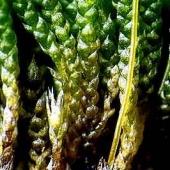Please select root levels for the menu
NZ Plants
Ephemeropsis trentepohlioides
Family: Daltonaceae
-
Gametophyte filaments (protonemata) and sporophyte capsules on branch of Raukaua anomalus
C Johnson (coll. by D Glenny)
View picture -
Protonemata with sporophytes
C Johnson
View picture -
Protonemata with sporophytes
C Johnson
View picture -
Protonema filament, older portion further back from the growing tip
L Jensen
View picture -
Protonemata with adult gametophyte leaves at base of capsule stalk (seta)
L Jensen
View picture -
Capsule with calyptra cover
L Jensen
View picture -
Immature capsule with lid (operculum)
View picture -
Open capsule with peristome teeth
L Jensen
View picture
Ephemeropsis trentepohlioides is an unusual moss. In most mosses, the spore germinates to form juvenile developmental stages called protonemata, composed of algal-like, branching filaments which eventually form buds that grow out into three dimensional leafy shoots. However, in Ephemeropsis trentepohlioides, the protonema is persistent and assumes the major photosynthetic role. When formed, buds are very small and develop into minute reproductive shoots bearing either antheridia or archegonia, surrounded by several small leaf-like bracts (perichaetial, perigonial bracts).
Widespread in New Zealand where it forms yellow-red-brown mats on living and dead bark, twigs and leaves of a number of native shrubs and trees.

